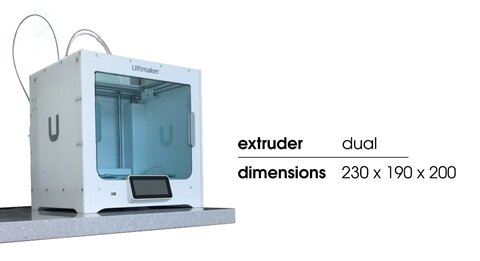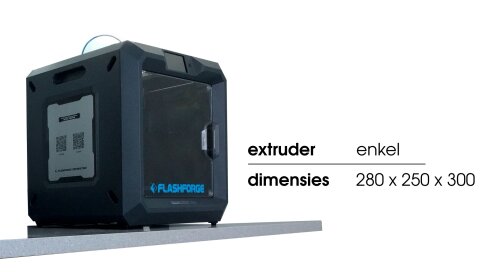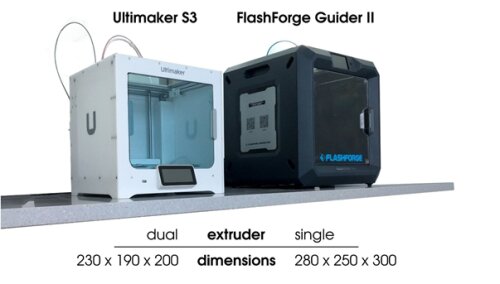Ultimaker S3

Flashforge Guider IIs

How to 3D print
1. Book
2. Create or download a design
3D designs are created using CAD software (Computer Aided Design)
Autodesk Inventor and Autodesk Autocad are available in the library. You can also find free online software, such as:
Save your design as an .stl or .obj file. You can download designs at Thingiverse or Instructables.
3. Check in
Check in with the library staff each time you use a device.
First time laser cutting in BibLab? Ask the library staff for a short introduction. There are also workshops you can attend.
4. Choose a printer and material
Biblab has two 3D printers:
| Ultimaker S3 | Flashforge Guider IIs | |
| extruders | 2 | 1 |
| dimensions | 230 x 190 x 200 mm | 280 x 250 x 300 mm |
| material | PLA and PVA 2.85 mm | PLA 1.75 mm |

Choose printing material
In BibLab we solely print with PLA and PVA filament. During printing the filament is heated (app. 220°C) and guided through the print head to build the object layer by layer.
- PLA (Polylactic Acid) is an organic compound and suitable for printing in small detail.
- PVA (Polyvinyl alcohol) is a water-soluble synthetic compound that is used to print supporting branches in complex 3D designs. PVA is suited for 3D printers with two extruders, such as the Ultimaker S3, or printers with a dual-feed system.
The Ultimaker S3 uses different print cores for different materials. Replace the print core when necessary. To do this, follow the instructions on the printer display.
- Use type AA print core for printing PLA
- Type BB is only for printing PVA
5. Slice your design with the appropriate software
Start by saving the design that you drew, scanned or downloaded as an .stl or .obj file.
Secondly, convert the .stl or .obj file to a file format compatible with our printers. To do so you open the .stl or .obj file in the slicer software affiliated with the 3D printer you choose to use. This software ‘slices’ the design into a printable layer-by-layer object. After slicing, the software will show errors in the design so you can fix them before printing, estimate the amount of filament that is needed, and the printing time required. It enables you to adjust the printing settings regarding the material, support, colour and size of your object.
- Ultimaker S3 uses the Ultimaker Cura slicer software
- Flashforge Guider IIs uses the FlashPrint slicer software
6. Have your design approved by the library staff
The library staff will review your design. Together
you will assess the cost and feasibility of the print, and the necessity of supports.
7. Print
Once your design is sliced, you can print it. This can be done from the computer in BibLab, or directly from the printer using a USB stick.
Be prepared for long printing times. This can quickly add up to several hours. In BibLab you can only print during office hours. By exception, you can also print until the next day until we open, but then you pay for the print in advance. You then also pay if something goes wrong with your print due to the device.
8. Finishing
After printing, the object must be removed from the print bed. Ask help from the library staff when doing this a first time.
- Let the object and printer cool down.
- Use a spatula when the object is hard to separate from the print bed.
- Ultimaker S3: remove the print bed form the printer to prevent damaging the print bed’s latches.
- Remove optional support parts by dissolving them in water (PVA) or cutting them off (PLA).
9. Pay
Filament is charged by weight. You can pay by Bancontact or payconiq at the library counter.